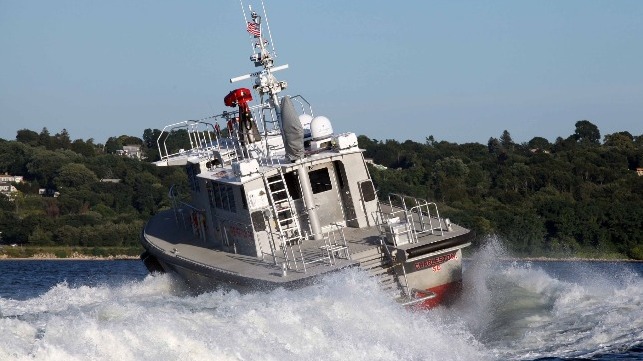U.S. Salvage and Firefighting Capabilities Questioned

Rapid Ocean Response Corporation has encouraged vessel owners to consult with their legal counsel regarding the validity of the contracts they owners rely upon with their salvage and firefighting response resource providers.
The company notes that a panel comprised of former U.S. Coast Guard admirals, marine safety experts and senior attorneys has concluded that vessel owners’ ability to comply with the Clean Water Act and related salvage and marine firefighting regulations in two Captain of the Port Zones is highly doubtful.
The Panel, comprised of VADM Brian Salerno, RADM Joel Whitehead, and RADM Roy Nash, as well as senior attorneys Captains Laticia Argenti, and David Nichols, examined compliance with the fire-fighting components of the regulations requirements in the Captain of the Port zones for Long Beach/Los Angeles, California, and Charleston, South Carolina.
Their conclusions were reached after over four months of research, interviews with response resource providers, subcontractors and verification simulations at these two ports.
The Panel’s findings addressed both the legal and operational requirements. As to the legal requirements, the Panel noted that the contracts and subcontracts, which provide the underpinning of vessel response plans, are not contracts at all, but, are instead mere letters of intent. These letters of intent do not require response resources to respond at the time of an incident and therefore are legally deficient. Specifically, the agreements fail to satisfy the definition of “contract or other approved means,” and fail to “ensure” the availability of the resources.
The Panel concluded: “When viewed as a whole, it is clear that Congress and the Coast Guard intended that the salvage and marine firefighting regulations improve response readiness in a real and meaningful way. The plain language of the regulations supports this notion. They require, in no uncertain terms, that capable salvage and marine firefighting response resources will be available when called upon.
“To accomplish this, proper legal instruments must be in place to accomplish that goal. Such is currently not the case. The subcontracts between resource providers and their vendors should truly “ensure” that response resources are “available.” That is what the law requires.
“Agreements between vessels of opportunity owners and resource providers are not contracts but non-binding letters of intent that leave response vessel availability completely at the discretion of the subcontractor. Such agreements fail to meet the definition of “contract or other approved means” as defined by the statute and regulation and seriously undermine the planning requirements as set out by Congress and the Coast Guard.”
Operationally, the chances of mounting a response within the regulatory timeframes in these ports for the distant nearshore and offshore areas of coverage is highly unlikely, states the Panel. A multitude of tasks must be completed in proper succession and within the regulatory time frames to initiate a compliant response.
The vessel of opportunity approach to compliance requires the vessel owner, or his nominee, to first identify and secure the services of a response vessel. Once under contract, the response vessel must invariably return to port, locate the pre-positioned equipment, be retrofitted with the equipment and secure a properly licensed offshore crew. Delays related to the transport of fire teams located outside the port nearest the incident, vessel refueling, and provisioning, add to the complexity of the response.
The Panel recognized that completing these undertakings successfully, and within the mandated timeframes, was highly doubtful. Some of the key conclusions reached by the Panel include:
“The reliance on non-contracted Vessels of Opportunity is highly problematic as these vessels are under no obligation to respond if called upon, yet they are critical to most salvage and marine firefighting plans. The Panel further concludes that without improving the verification process, ensuring the actual availability of response resources and personnel, and taking appropriate enforcement action when necessary, there is no incentive for the system to improve and it will likely remain in a substandard state.
“Meaningful Coast Guard oversight of resource providers is lacking. There appears to be too much Coast Guard reliance on resource provider representations and a lack of an actual, practical verification of those representation.
“The Coast Guard salvage and marine firefighting response resource verification process is inadequate and does not properly test whether equipment and personnel listed in Vessel Response Plans will be available and capable for an actual response should an incident occur.”
Noting the findings, Rapid Ocean Response CEO Nicholas Nedeau noted: “A confluence of events has created a perfect storm for vessel owners. First, the law places the burden of compliance squarely on the vessel owners. Secondly, the Coast Guard has accepted plans that rely on an approach to compliance that is unreliable and legally insufficient. Thirdly, the lack of enforcement by the Coast Guard has given vessel owners a false sense of security. These problems manifested themselves in the recent offshore fires of the Caribbean Fantasy and Bouchard barge 255.”
Nedeau says vessel owners would benefit from requesting to obtain access to the Geographic Specific Appendices for each Captain of the Port of their Vessel Response Plans that lists the actual response resources to conduct their own independent review of the response resources’ locations and capabilities.
The opinions expressed herein are the author's and not necessarily those of The Maritime Executive.
